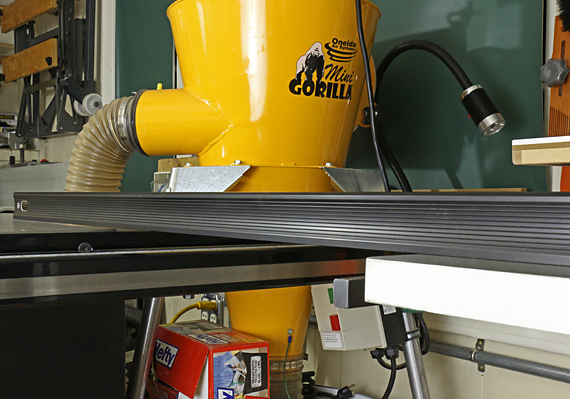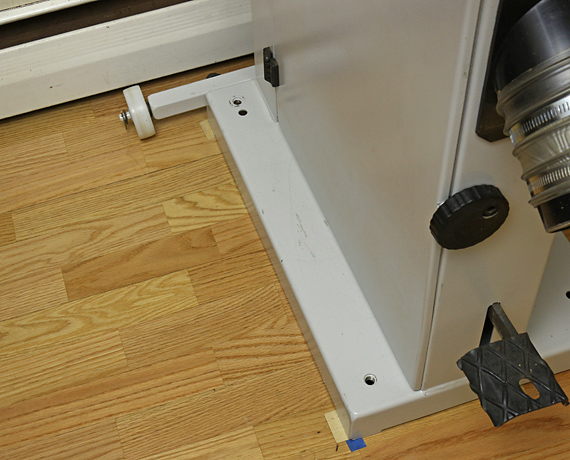
I think we would all welcome more shop space but realistically most of us contend with making better use of the space we have. Here’s another tip for that.
For combined machine and hand tool woodworking, shop space is usually governed primarily by the major machines, and then by wood storage, and the workbench. For the table saw, bandsaw, jointer/planer, and router table the required space includes not only the machine itself but, even more, the ranges of the infeed and outfeed. Manipulating these ranges can produce more functional shop space.
Coordinating the different heights of the machine tables is one trick to help. I covered that in a previous post. However, sometimes that can be difficult, so think also of the angle of the tables. Tiny differences there can pay off.
This is what you have to do when your shop is only 200 square feet.
During a recent bandsaw tune-up, I re-shimmed the table on the trunnion assembly. Oops, that made the bandsaw table just at the same height as the nearby table saw top. There was no infeed clearance for using the bandsaw in its usual location.

No problem. A pair of wooden shims, only about 1mm thick, placed on one side of the bandsaw base, tilted the machine enough (less than 0.2°!) so that the infeeding wood safely clears the table saw, plus some allowance for bowed boards. In the photo at the top, the straightedge is flat on the bandsaw table in the right of the photo, but notice in the left of the photo that it clears the table saw surface.
The only interference that this arrangement causes with table saw work is very wide ripping, on the order of 24″, which I rarely do, but all my machines are on wheel bases, so they can be moved to allow those jobs too.


I also work for a compact arrangement of my major tools. My arrangement is a bit different (bandsaw and tablesaw are back-to-back, with the bandsaw blocked up so outfeed can clear the table saw).
It looks like a very tight squeeze between tablesaw and bandsaw — does this get awkward? I do find myself not going to the bandsaw as much since I need to walk around the tablesaw to get to it, and then have limited space behind me (garage door, that can be opened if needed).
Also, how is the dust collection?
Matt
It looks tighter in the photo than it really is. There’s enough space that I don’t have to alter my stance while working at the bandsaw.
Dust collection with the Oneida Mini Gorilla is excellent.
Rob
This is a theory I have also been toying with. I trying to figure out if I can fit a Hammer machine in my 140 sq ft shop. I am looking at varying table heights so work on one machine will pass over another.
Sam, if it’s a Hammer jointer-planer you’re considering, please see the series of posts I wrote on their A3-31 j-p, which I own and like a lot.
http://www.rpwoodwork.com/blog/tag/jointer-planer-combo/
Rob
I may have your write up memorized by now! I think I am going to end up with the 10″ model. First step is to get dust collection in. I would really like a mini-gorilla but the foot print is concerning. I need to see the new model in person to take some measurements. The jigsaw puzzle of 140 sq ft is not easy.
Thanks, Sam. I’d lean toward the 12″ (A3-31) if you possibly can. The difference from the 10″ in footprint is small, and, depending on the work you do, you may come to really appreciate that full 12″ of jointing capacity, as I do.
The footprint of the Mini Gorilla is quite small – barely more than a shop vac. I bet you can fit it in your 140 s.f.
My shop layout is detailed in Fine Woodworking #237. Though I’ve revised a few things since then, it’s basically still the same.
Rob
I didn’t know with your bandsaw-centric approach if you had ever considered going towards a tracksaw/MFT table for crosscutting to compliment the BS versus having a table saw? I have a mini gorilla dust collector and will 2nd its dust collection effectiveness and small footprint.
John
Hi John,
Nah, for machines, I’d generally rather move the wood than the cutting tool – bandsaw, table saw, jointer, planer, and router table. Just a personal preference, and I do see how the tracksaw/MFT would save space and tonnage. But I’m also not much of a Festool fan.
Rob